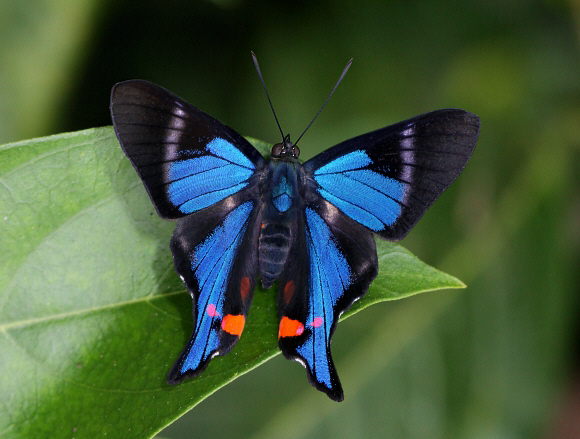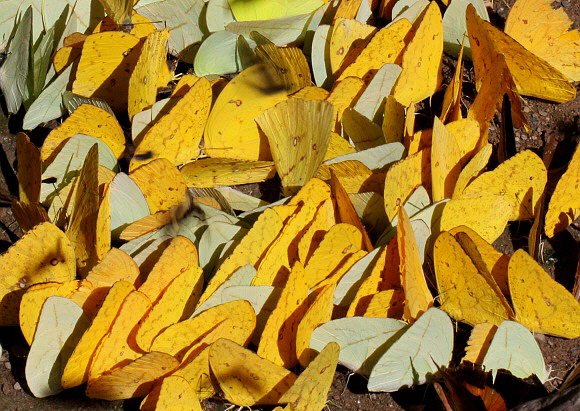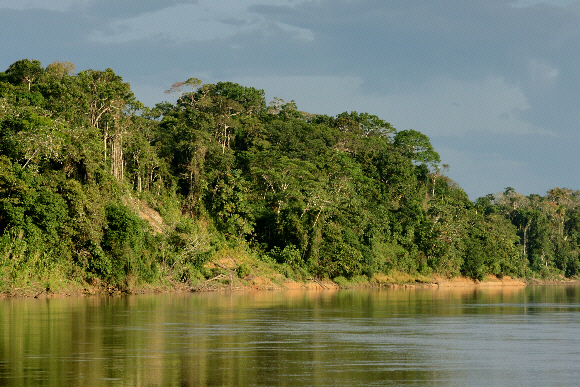The Most Precious Environment on Earth
A rainforest experience, described by Adrian Hoskins
It is 6.00am, and we are awoken by the raucous echoing call of a troop of howler monkeys. They are perhaps 2 km away, but the sound fills the forest around us. Dawn is breaking as we venture along a trail through the primary rainforest.
Mysterious butterflies flit around us. I spot where they have settled, but their amazing camouflage makes them almost impossible to locate. Some, like Taygetis angulosa look exactly like dead leaves. Others, like Haetera piera, Cithaerias pireta and Ithomia agnosia are almost entirely transparent. Enormous Caligo Owl butterflies flit from one tree trunk to another. Their wings have a feathery appearance and are marked with false ‘owl eyes’, enough to startle any predatory bird and give the butterfly a chance to escape.
Every butterfly species here has its own distinct personality. The zebra-striped Colobura dirce sits motionless on tree trunks as it feeds at sap runs, but if disturbed, instead of taking flight it scuttles around to hide on the opposite side of the tree. The striped hairstreak Arawacus separata sits facing sideways on a leaf, but as soon as you get within a metre, it rotates to show you its posterior!
Like many other butterflies it seems to take delight in taunting human observers, but its odd behaviour is simply a survival strategy – by rotating it narrows its profile and is much harder for a predator to spot. Butterflies use many strategies to hide themselves from predators. Many use camouflage or disguise. Others, such as the Eurybia Riodinids and the Nascus skippers, hide under leaves, darting out periodically to investigate intruders, before disappearing again beneath another nearby leaf.

Rhetus periander, Peru – Adrian Hoskins
We come to a small glade, the site of a peccary mud wallow. Hundreds of butterflies are swarming around us – gorgeous black and yellow swallowtails, brilliant red and black Callicores, bright orange Julias, and Morphos – dazzling metallic blue butterflies the size of saucers. The muddy ground in the glade is carpeted with butterflies, which settle at our feet to imbibe at the mineral-rich mud. Male butterflies obtain vital chemicals this way, and pass them to females during copulation.
There are myriads of butterflies here, and it’s impossible to walk without treading on them. Amongst them are glittering green Caria Metalmarks, red Marpesia Daggerwings and the stunning Blue Doctor Rhetus periander. At the edge of the glade we watch a Starry Night Hamadryas velutina basking head-downwards on a tree trunk. It is possibly the most beautiful butterfly we have seen today, with large velvety black wings adorned with hundreds of shimmering blue spots.
11.00am – It is hot now, and the forest resounds with the call of giant cicadas. The sound begins as a slow hesitant clicking, gradually accelerates to a rattle, then a hum, and escalates into a haunting siren wail which fills the air for a few moments before fading again into silence.
We have been here for 6 days, and seen almost 300 butterfly species, several of them previously unknown to science. Every step along the trails reveals exciting new finds – huge helicopter flies, strange hemipteran bugs, weird beetles, stick insects, and praying mantises.
A little later we climb the canopy tower. As we ascend we notice that every layer in the forest has its own characteristic butterfly fauna – Pierella Lady Slippers and Taygetis Dead-leafs at ground level, Tiger-mimics at about 3 metres, Heliconius at 10-20 metres. Many species, particularly the hairstreaks and metalmarks spend their lives almost entirely in the tree tops, and rarely descend to ground level. After a tiring climb we finally arrive at the top of the tower. We spend a relaxing half hour watching red and green macaws, great egrets, snail kites and oropendolas flying past.
It is difficult to drag ourselves away, as the view across the vast expanse of pristine rainforest is awe-inspiring, but it is time for lunch, so we descend to ground level and slowly wander back along the trails to our base. We are so distracted by the myriads of butterflies seen along the route that we arrive late, and are so busy talking about the marvels we have seen that we barely find time to eat.
 Phoebis argante and Rhabdodryas trite swarming on an Amazonian tributary – Adrian Hoskins
Phoebis argante and Rhabdodryas trite swarming on an Amazonian tributary – Adrian Hoskins
In the afternoon we travel upriver by dugout canoe. Amazon kingfishers swoop past, a harpy eagle hovers high in the sky above us. On a nearby rocky island we see a caiman basking, and along the riverbanks we see sun bitterns and the beautiful capped heron.
Strings of bright yellow Eurema and Phoebis butterflies fly in follow-the-leader fashion along the river’s edge. Hundreds gather to imbibe moisture on the sandbanks, erupting into flight as our boat passes. We notice how most butterflies congregate with others of their own species – there are clusters of Marpesia Daggerwings, groups of Heraclides Swallowtails, and flocks of Protesilaus Swordtails and bright orange Julias. Many different species come and go throughout the day, until late afternoon, when a swirling swarm of migrating Eunica Purplewings arrives and ousts every other species.
We stop at various places along the river to explore the trails. Imaginary snakes wait to strike from behind every tree. But they are not all imaginary. Clambering up a riverbank we suddenly find our-selves confronted by an enormous anaconda with a massive head and a body 8 metres in length! Luckily for us it has already eaten – its belly greatly distended by the capybara which became its breakfast!
As the day cools down, we journey back along the river. Beautiful birds fly across our path – green ibis, ringed kingfisher, striated heron, kiskadee, paradise jacamar. A giant river otter inquisitively pops its head out of the water next to the boat. A capybara, looking like an enormous guinea pig, looks across at us from the riverbank.
During the next half hour we see a dozen tapirs, amongst the most enchanting and gentle of all animals, emerging from the forest at different spots along the riverbank. Back at our base the light is fading fast, and the howler monkeys roar again. We sit down for our evening meal, comparing notes about the wonders we have seen, and agree that this is probably the most wonderful place on Earth.

Rio Madre de Dios, Peru – Adrian Hoskins
The next morning we travel downstream for an hour, disembark from our dugout, and get into a jeep. We leave behind the beautiful pristine rainforest, travelling through secondary forest and then for several miles through cattle pastures, until we come to the town where we catch a plane to our next destination. For 4 hours we fly across what was formerly rainforest, but all we see is a huge expanse of semi-desert. The forest has all been burnt down and turned into cattle pasture, but the pasture only lasts for a few years, and all that remains now is a barren dusty landscape dotted with termite mounds. Looking down from our plane we see a dead parched world, devoid of life.
We have been told that our next destination is an oasis – an ‘island’ of pristine rainforest that has miraculously survived amidst a desert of failed cattle ranches in the state of Rondonia. Our plane lands and we board a bus. For the next 5 hours we are driven across 200 miles of devastated land. The forest has gone, the cattle ranches have failed, and the air is hot, dry and dusty. By the time we arrive at our base we have a feeling of the most intense grief.
Many of us, all grown men, are in a state of stunned silence. We have left the most wonderful and precious environment imaginable, and now realise the full horror of what is happening in Brazil. The foul air around us is thick with smoke, our eyes are watering, and we are struggling to breathe.
The spot where we are now standing was once the richest butterfly site known on Earth. Just 30 years ago it supported over 1500 butterfly species, but now they are very scarce. Within 5 years they will almost certainly be lost forever. For 4 days we search the tiny fragment of forest that still remains here, looking in vain for butterflies, muttering in disbelief at what has happened here. The incredibly rich forest, teeming with life, has been devastated, the life is gone.
Please help to save rainforests, by signing on-line petitions and lobbying politicians.
